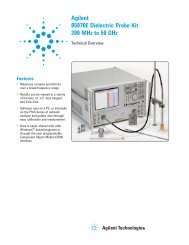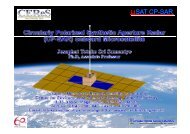Create successful ePaper yourself
Turn your PDF publications into a flip-book with our unique Google optimized e-Paper software.
J.Oto.Ktrl.Inst (J.Auto.Ctrl.Inst) Vol 1 (2), 2009 ISSN : 2085-2517<br />
As compared with the conventional linear polarization SAR, most of the above-mentioned<br />
effects can be alleviated through the use of CP-SAR. Thus, a CP-SAR sensor would provide a<br />
greater amount of information about scenes and targets being imaged than a linear SAR<br />
sensor. The present work focuses on the design of an L-band CP-SAR antenna. We consider<br />
the SAR system requirements to achieve an excellent performance of the overall CP-SAR<br />
system, including optimization of the single element patch and array designing.<br />
2 Circularly Polarized SAR Antenna Requirements<br />
Table 1. Specification of CP-SAR onboard Unmanned Aerial Vehicle<br />
Parameter Specification<br />
Frequency f 1.27 GHz (L band)<br />
Chirp bandwidth 10 MHz<br />
Polarization Transmitter : RHCP<br />
Receiver : RHCP + LHCP<br />
Gain G > 20 dBic<br />
Axial Ratio AR < 3 dB (main beam)<br />
Antenna size 1.75 m (azimuth)<br />
0.5 m (range)<br />
Beam width 8º (azimuth)<br />
25º (range)<br />
Altitude range 3,000 - 10,000 m<br />
The capability of a SAR antenna can be described by its sensitivity, spatial resolution in<br />
range and azimuth directions, image quality, ambiguities, and swath coverage [1]. Table 1<br />
shows the specifications and targets desired for the present CP-SAR system, which in turn<br />
influence the specification of the L-Band CP-SAR antenna.<br />
The operation frequency of 1.27 GHz (L-band) has been chosen, since its relatively longer<br />
wavelength ensures better penetration through vegetation canopies. The drawback<br />
associated with this choice, however, is the relatively large dimension of microstrip<br />
elements. The requirements for the range resolution (15 m) determine the antenna<br />
bandwidth of 10 MHz, or less than 1% of the operation frequency of 1.27 GHz. This<br />
bandwidth requirement must be compatible with a low axial ratio (AR) (below 3 dB) for<br />
ensuring transmitting/receiving circularly-polarized waves. To satisfy the matching of input<br />
impedance, the return loss must be smaller than 10 dB in this bandwidth range.<br />
3 CP-SAR Antenna Concept Analysis<br />
The primary considerations in the design and fabrication process are low cost, light weight<br />
and ease of manufacturing. The CP-SAR antenna is conceived in the way that every single<br />
element microstrip patch is a circularly polarized antenna. Feed network will be<br />
implemented in different layer substrate as the feeding method is proximity coupled.<br />
2






